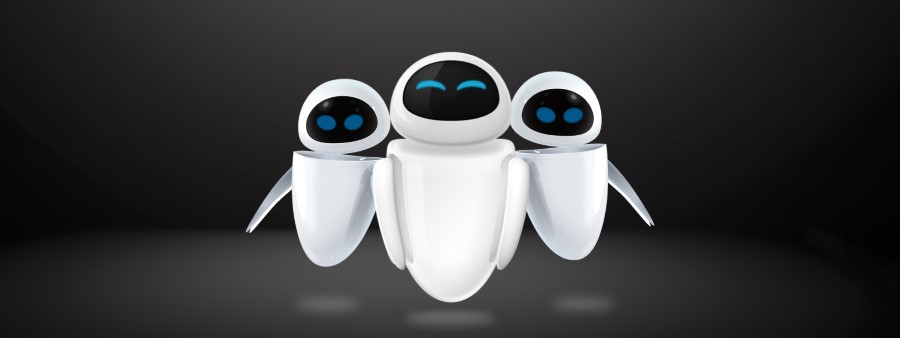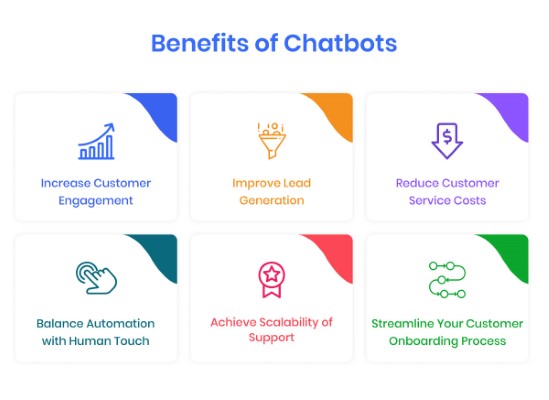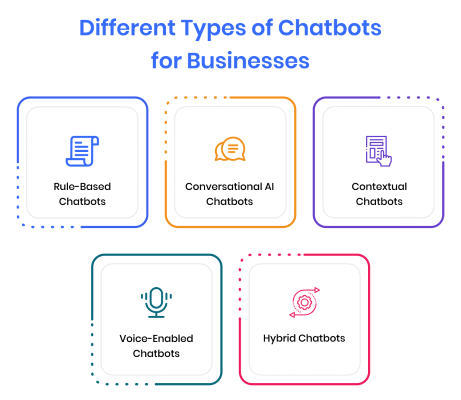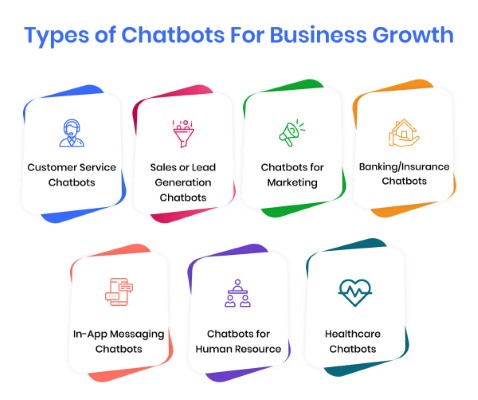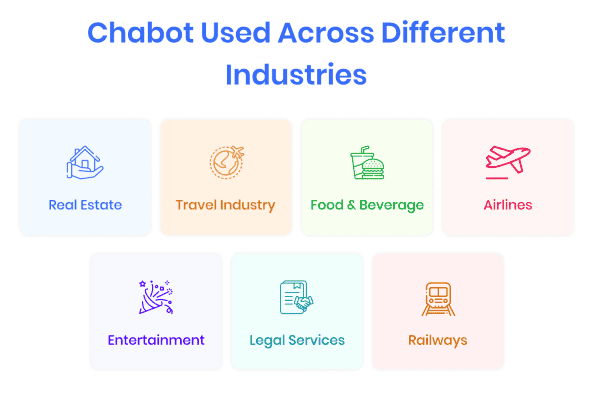Business communication has been greatly influenced by chatbot technology. The global chatbot market is going to reach $9.4 billion by 2024.
Thousands of companies worldwide, SMBs to enterprises are developing various types of chatbots that focus on accelerating their customer experience and curtailing support costs.
Chatbots are supporting companies to engage and interact with potential and existing customers 24/7.
You might be wondering how many types of chatbots are there. There are hundreds of types of chatbots but the classification of chatbots depends on two main things:
- Business Use Cases – the problem you are trying to solve
- Chatbot Functionalities – the features you are trying to incorporate
In the article below, we will help you understand the different types of chatbots, what these are used for, and what type of chatbot technology could have the biggest value for your business.
Prior to discussing the different types of chatbots, let’s take a glance at the top benefits of chatbots, which is why more and more businesses are deploying bots.
Why do Businesses Need to Leverage Various Types of Chatbots?
Businesses deploy different types of chatbots based on their use cases starting from streamlining the business processes to enhancing customer engagement and increasing productivity. Bots help to convert users to customers, drive sales, and improve the overall consumer experience.
Let’s take a look at the key advantages of a chatbot.
- Increase Customer Engagement – Bots can deliver quick answers by being 24×7 available which encourages customers to stay longer on your website and maintain the conversation.
- Improve Lead Generation – Businesses can use chatbots for lead generation to guide customers in making quick decisions. Bots use a preset questionnaire to persuade visitors for lead generation and ensure higher conversion rates.
- Reduce Customer Service Costs – Implementing chatbots is an investment to optimize customer service costs. Bots can save you extra costs that otherwise go into hiring more support resources, infrastructure, training, etc.
- Balance Automation with Human Touch – You can understand the difference between chatbot vs live chat and try to integrate them together for better customer service. The smooth transition between chatbot to live chat provides real-time responses to the customers, giving them the best hybrid experience.
- Achieve Scalability of Support – Chatbots are easily scalable to effectively handle peak hours without the need to add more support reps or other costs.
- Streamline Your Customer Onboarding Process – Customers like to be guided no matter how many support tutorials you offer them. Chatbots prove to be handy to educate customers and ease the onboarding process.
REVE Chatbot platform offers you default templates to build bots and to customize too as per your business needs. Signup for 14 days free trial to test drive REVE Chat’s chatbot platform.
Five Different Types of Chatbots for Businesses
A chatbot deployed on the eCommerce website would be totally different from the one implemented on the banking site. Just as humans contrast in personality, traits, or capabilities, the same goes for chatbots.
Here we will discuss what are the different types of chatbots, their applications, and their functionalities. It will give you a fair understanding of chatbot classification and what would be the ideal chatbot type for your business.
So, let’s dive in.
1. Rule-Based Chatbots
Rule-based chatbots also referred to as decision-tree bots, use a series of defined rules. These rules are the basis for the types of problems the chatbot can be familiar with and deliver solutions for. Like a flowchart, rule-based chatbots map out conversations.
Rule-based or scripted are the types of chatbots that can be used to answer common questions – for instance, booking a table in a restaurant or buying tickets to the cinema. Followed by a decision tree, the customers are provided a set of predefined options that leads to the relevant answer.
2. Conversational AI Chatbots
AI-enabled chatbots combine the power of Machine Learning (ML) and Natural Language Processing (NLP) to understand the context and intent of a question before formulating a response.
Such conversational AI bots generate their own answers to more complicated questions using natural-language responses. The more you use and train these bots, the more they learn and the better they operate with the user.
Conversational chatbots are a win over rule-based bots in the identification of user context and intention. They can thus decipher a user’s query and deliver a personalized experience.
3. Contextual Chatbots
The most advanced type of conversational chatbot is a contextual bot.
In order to remember the conversations that happened earlier, these types of chatbots make use of Machine Learning (ML) and Artificial Intelligence (AI), with particular users, to learn and grow with the passage of time.
Contextual chatbots learn by experience with the user. A few examples of these chatbots are Google Assistant, Siri, Alexa, etc.
4. Voice-Enabled Chatbots
The voice-enabled type of chatbot makes personalized experiences for users. To make conversational interfaces even more vernacular, businesses are now using voice-based chatbots or voice bots.
The voice-enabled chatbots accept the user’s input when they speak, act upon the request, reply to queries, and perform numerous creative tasks. By using text-to-speech (TTS) and voice recognition APIs, businesses can make their own voice-activated chatbot.
Voice bots have been on the rise for the last couple of years, with virtual assistants like Apple’s Siri, and Amazon’s Alexa, and why?
Because of the convenience they bring. It’s much easier for a customer to speak rather than type. A voice-activated chatbot brings frictionless experiences directly to the end customer.
5. Hybrid Chatbots
Hybrid chatbots are an amalgamation of simple (rule or script-based) and smart (conversational AI-based) AI-based.
The hybrid chatbot model offers the best of both worlds- the simplicity of the rules-based chatbots, with the complexity of the AI bots.
These bots have some rule-based tasks, and they can understand intent and context. It makes them a balanced tool for businesses to interact with customers.
Types of Chatbot’s Purpose For Business Growth
Did you know which industries are benefiting from chatbots? The finance, healthcare, education, travel, and real estate industries. Also, roughly 80% of businesses are projected to integrate some type of chatbot technology by 2023.
Here is the categorization of all types of chatbots under their respective purposes. Let’s have a look!
#1. Customer Service Chatbots
Customer service is one of the vital business functions where chatbots have a great impact. 67% of consumers worldwide used a chatbot for customer support.
Customer service chatbots can help businesses to engage clients by answering FAQs and delivering context to conversations. Businesses can save support costs by speeding up response times and improving first response time which boosts user experience.
Key use cases of support chatbot:
- Automate website support: Deploying chatbots on your website boosts operational efficiency and offers convenience to customers. Bots not only streamline customer experiences at every stage in the service process but are also aids to the support agents.
- Handle helpdesk support: Bots are self-learning software systems that analyze human language. They can help your IT help desk to boost team productivity and drive efficiency.
- Collect customer feedback: Chatbots are a great way to acquire customer feedback. By following the chatbot best practices, you can generate a high level of engagement that encourages customers in completing surveys.
- Order confirmation & tracking shipping: Support chatbots are the best way to combat the traditional process and deliver an excellent brand experience. Customers can stay updated easily just by entering the shipping id.
- Handle refunds & return requests: Chatbots can handle common queries by reducing support tickets and increasing team productivity.
#2. Sales or Lead Generation Chatbots
Leveraging sales bots help businesses in asking contextually relevant questions, qualifying leads, and booking sales meetings, at scale.
Chatbots convert 4x higher than traditional lead generation tools because people prefer conversations. So, engage with your visitors 24×7, to interact, and generate more leads.
Key use cases of sales chatbot:
- Automate sales funnel: Lead generation chatbots can create exceptional conversational experiences for website visitors and qualify them at scale. The leads are then directed to the right sales rep for closing sales immediately or booking an appointment.
- Lead nurturing: Leveraging sales chatbots can nurture leads by engaging customers in different ways like – giving personalized product recommendations, suggesting the best combo offers, or offering discount coupons to boost sales.
- Appointment bookings: Advanced AI bots that meet the latest artificial intelligence trends can enable automated appointment booking to help customers book instantly from your website or Facebook page.
- Place online orders: 1 in 5 consumers would consider purchasing goods and services from a chatbot. Be it food, electronics or apparel chatbots are prompt in handling online orders.
#3. Chatbots for Marketing
Chatbots are greatly revolutionizing the marketing ecosystem for many businesses, while the goal remains the same for all i.e. instant and convenient service.
Key use cases of a marketing chatbot:
- Better customer engagement: Chatbots can engage with your customers with immediate responses and increase customer satisfaction, which makes them happy to retain your brand.
- Offer product recommendations: AI bots can help your customers to proceed to the final stage of the sales funnel by recommending relevant products that they might be interested in.
- News chatbots: Chatbots save time by getting curated news and headlines right inside your messenger. Many popular news portals and television networks introduced chatbot services. CNN was one of the first news businesses to build a bot on the Facebook Messenger platform.
#4. Banking/Insurance Chatbots
Chatbots are effortlessly enhancing the digital customer experience in banking and also achieving a range of other benefits.
From balance inquiries to account openings to quick replies, banking bots can help serve users promptly and efficiently, therefore enhancing the customer experience.
Key use cases of a banking chatbot:
- Automate customer support: AI bots help banks in automating support for common queries and focus more on serving the customers in a better way. The customer service chatbots can handle non-complex queries related to banking products and customer accounts.
- Reminders and notifications: Chatbots can send timely reminders and routine notifications to customers that include bill payment deadlines, the last days of some loan offers, etc.
- Proactive customer communication: AI-powered bots can be deployed within an app or on the website, or on browsing pages to pre-empt customers with quick answers.
- Financial advice and assistance: Bots leveraged on the bank websites or within the app as a personal financial guide. Banks will have many ways to use chatbots for financial services and improve customer experience.
#5. In-App Messaging Chatbots
Chatbots that are integrated with a social messaging platform like Messenger, Telegram, Slack, Whatsapp, etc are termed messaging chatbots.
Customers prefer brands offering bot support. 47% of users are open to purchasing items through a bot.
Chatbots can engage customers by answering their simple queries when the support team is busy or not available.
These types of chatbots make it simple for customers to directly connect with the bot using social media handles just like the way they talk to their friends.
Social messaging chatbots can sell and process orders, track order information, and answer frequently asked questions (FAQs). It cuts down a lot of costs for online businesses and also offers instant interaction to users.
#6. Chatbots for Human Resource
Recruitment is an important part of HR activity. With chatbots, tasks can be handled seamlessly.
Human Capital Trends report found that only 17% of global HR executives are ready to manage a workforce with people, robots, and AI working side by side.
The chatbot acts as a recruiting assistant and manages large candidate pools so that the recruiters and hiring managers have more time to focus on interviews and closing offers.
#7. Healthcare Chatbots
Healthcare chatbots help in automating all the repetitive, and lower-level tasks of the medical representatives. While bots handle simple tasks seamlessly, healthcare professionals can focus more on complex tasks effectively.
Key use cases of a healthcare chatbot:
- Easy appointment scheduling: Healthcare bots are a great way to overcome the challenge of the patients to navigate the scheduling systems. With a messaging interface, website/app visitors can easily access a chatbot.
- Effective patient engagement: AI-enabled patient engagement chatbots in healthcare provide prospective and current patients with immediate, specific, and accurate information to improve patient care and services.
- Gather patient information: FAQs related to the patient’s name, address, contact number, symptoms, current doctor, and insurance information can be used to extract information by deploying healthcare chatbots.
- Recommend wellness programs: Healthcare chatbots backed with NLP can understand user intent with the help of sentiment analysis. Based on the understanding of the user input, the bot can recommend appropriate healthcare plans.
#8. Social Media Chatbots
One of the vital undeniable aspects is to engage with customers where they are.
With an increase in messenger platforms for business, one of the most important channels is social.
Chatbots significantly boost user engagement on these popular social websites and communicate with customers through live chat platforms like Facebook Messenger.
Bots are taking over social media marketing as they allow consumers to engage with them in terms of customer service, and transactional engagements.
Different Types of Chabot Used Across Different Industries
Chatbots are of different abilities from different chatbot platforms and fulfill various purposes in each industry. Different types of chatbots can be used for different businesses, from those that deal with simple requests, to those that handle advanced queries.
Here are some use cases for different industries and examples of how they have been deployed.
- Real Estate: Real estate is a relationship-oriented industry by nature. Chatbots can’t replace that client-agent relationship, but they can replace agents in answering general real estate questions. Holmes is a real estate chatbot that uses AI to answer customer queries in real time.
- Travel Industry: The travel and tourism industry witnessed more international customers willing to do business. One of the problems with the travel business is catering 24×7 support. Chatbot, allows you to handle customer queries and generate leads around the clock. Hello Hipmunk is a completely free and helpful bot that does all the work for you.
- Food & Beverage: The food industry is one of the industries that has experienced the most success with chatbots. Pizza chains have been among the most prolific adopters of chatbot technology. Domino’s is the first major brand to launch a chatbot on Facebook Messenger and generates nearly $5bn a year.
- Airlines: Many airlines are deploying chatbots to help their customers answer common questions and obtain basic information about their flights. Aeroméxico launched its chatbot to serve 1,000 customers per day.
- Entertainment: People use FB Messenger via phone every day, which is why Messenger chatbot games were developed. The most followed chatbot game is MojiHunt. It was followed by more than 20 000 users.
- Legal Services: Analyzing documents is a time-consuming process in the legal industry. JP Morgan Chase launched COIN bot to manage its back-office operations. It can analyze complex contracts quicker and more proficiently than human lawyers.
- Railways: IRCTC is aimed at facilitating accessibility by answering users’ queries pertaining to various services offered to railway passengers. They launched AI-powered voice-enabled ASKDISHA chatbot to converse with customers in the Hindi language.
Final thoughts
As technology continues to enable smart AI chatbots, more users will choose to interact with them in their everyday lives because the right chatbot knows how to respond appropriately to their concerns on time. For customer service firms, this means improved customer relationships.
The above article focuses on five different types of chatbots along with their purpose and key use cases. Also, there are different ways to implement the AI bot, depending on the use case.
Hopefully, you now know enough through this chatbot guide and are ready to implement one of the bots in your own business.
